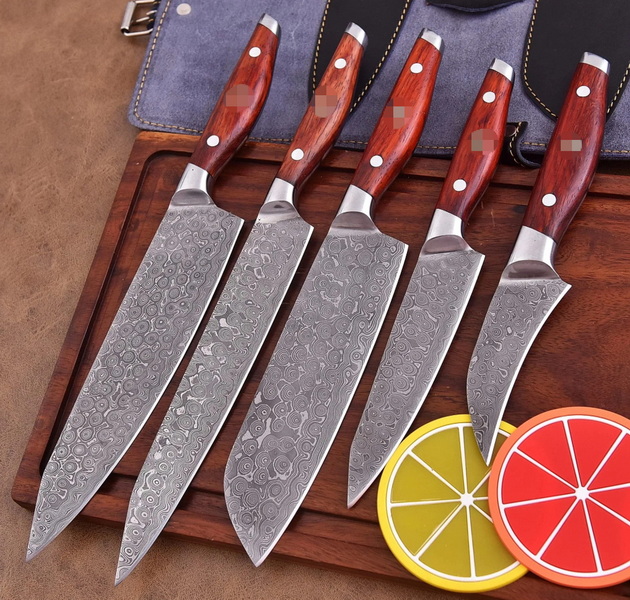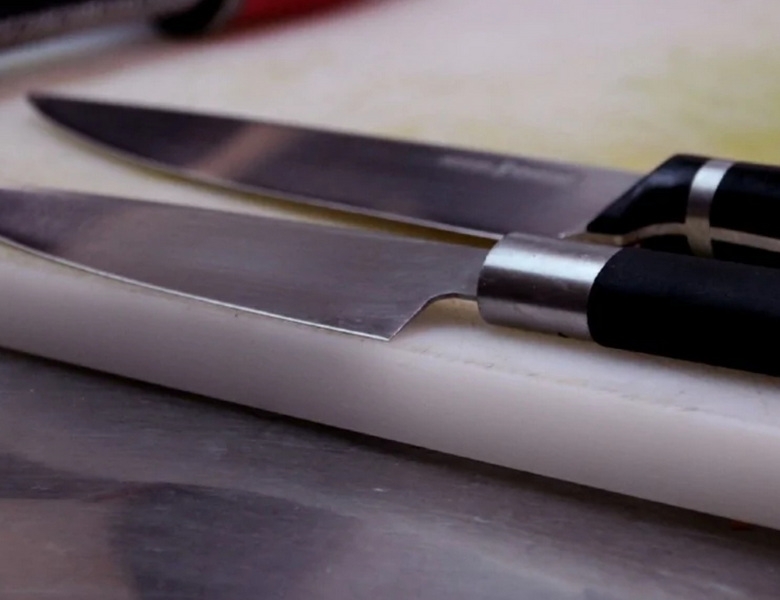- All
- Product Name
- Product Keyword
- Product Model
- Product Summary
- Product Description
- Multi Field Search
Views: 222 Author: Ann Publish Time: 2025-10-16 Origin: Site











Content Menu
● Understanding Damascus Knives
● Blade Design and Construction
● Advantages of Damascus Steel in Kitchen Knives
>> Sharpness and Edge Retention
>> Aesthetics
● Comparing Knife Features Side-By-Side
● Care and Maintenance of Damascus Knives
● Frequently Asked Questions (FAQ)
>> 1. What is the main difference between a Damascus chef knife and a butcher knife?
>> 2. Can I use a Damascus chef knife for butchering tasks?
>> 3. How do I maintain the sharpness of my Damascus knives?
>> 4. Are Damascus butcher knives common?
>> 5. Why do Damascus knives tend to be more expensive?
Choosing the right kitchen knife is essential for both professional chefs and home cooks. Among the most popular types are the Damascus Chef Knife and the Butcher Knife — each designed with specific tasks in mind. This article explores their differences, focusing on features, blade design, uses, and why Damascus knives are prized for their quality and beauty.

Damascus knives are renowned for their distinctive wavy patterns on the blade created by layering different steels together through a forging process. This not only enhances aesthetics but often improves blade strength and sharpness. The multiple layers forge a blade with exceptional hardness and flexibility, which resists chipping and holds a sharp edge longer than many other types of steel.
Damascus knives have become a symbol of craftsmanship, combining traditional forging techniques with modern steel technology, making them highly sought after for tasks ranging from delicate slicing to heavy-duty cutting.
- Damascus Chef Knife: Typically features a sharp pointed tip and a curved blade, ideal for precision chopping, slicing, and dicing. The curved edge allows a rocking motion for efficient cutting, reducing hand fatigue and increasing cutting speed. The blade usually ranges from 6 to 8 inches in length, making it versatile for a wide range of kitchen tasks.
- Butcher Knife: This knife usually has a thicker and longer blade, often ranging between 8 and 14 inches. The blade curve is more pronounced or sometimes flatter with a blunt or less distinct tip compared to a chef's knife. This shape is designed for breaking down large pieces of meat efficiently, allowing the user to cut through bones and tough joints. The heft and sturdiness support tougher tasks.
The blade thickness is a key difference between these knives. Butcher knives have significantly thicker blades to withstand the pressure of cutting through bones and heavy meat cuts, often nearly twice the thickness of a chef knife blade. The additional material adds durability and weight, which aids in forceful cuts.
Chef knives are thinner and more tapered, allowing for finer, more precise cuts. This thinner blade profile also helps for delicate preparations such as mincing herbs and slicing vegetables thinly.
- A versatile tool used for chopping vegetables, slicing fruits, mincing herbs, and cutting boneless meats.
- The sharpness and ergonomic handle design allow precise, controlled cuts using a rocking motion.
- Ideal for preparing ingredients that require finesse, such as garnishes and finely diced ingredients.
- Popular for general kitchen tasks because it can handle a broad range of food types efficiently.
- Designed specifically for butchering tasks such as breaking down whole animal carcasses.
- Can cut through thick meat, cartilage, skin, and bones.
- Used for trimming fat and sinew, skinning, and portioning meat.
- Its robust design makes it indispensable for heavy-duty meat preparation in professional kitchens or butchery.

Damascus steel blades hold their sharp edge much longer than other types due to the layered construction. The combination of hard and soft steel layers creates a blade that sharpens quickly but is also durable enough for intensive tasks.
The forging process used in Damascus knives imparts great toughness, making these knives resistant to chipping or breaking under pressure. They can flex slightly without losing edge integrity, ideal for fast-paced kitchen environments.
Each Damascus knife bears a unique, rippling pattern that distinguishes it visually. This pattern is both a mark of high craftsmanship and a decorative feature that appeals to enthusiasts and professionals alike.
| Feature | Damascus Chef Knife | Butcher Knife |
|---|---|---|
| Blade Length | 6-8 inches | 8-14 inches |
| Blade Thickness | Thin, tapered for fine cuts | Thick, heavy for durable cutting |
| Blade Shape | Curved with sharp pointed tip | Pronounced or flat curve, blunt tip |
| Weight | Lightweight for maneuverability | Heavier for force and pressure |
| Primary Uses | Slicing, dicing, chopping, mincing | Breaking down meat, cutting bones |
| Cutting Motion | Rocking chop | Blunt chop, hacking, slicing |
| Sharpness | Extremely sharp for precise cuts | Sharp but prioritizes power over finesse |
| Edge Retention | High, holds edge longer due to layered steel | High, durable blade for tough use |
| Visual Appeal | Unique wavy Damascus pattern | Less focus on pattern, mostly functional |
Caring for Damascus knives properly ensures longevity and performance.
- Cleaning: Always wash by hand with warm water and mild soap; avoid dishwashers.
- Drying: Dry immediately to prevent rust and spotting.
- Sharpening: Use a whetstone or professional sharpening service to maintain the fine edge.
- Storage: Store in a knife block, sheath, or magnetic strip to protect the blade.
In conclusion, the Damascus Chef Knife and Butcher Knife serve distinct but complementary roles in the kitchen. The chef knife is prized for its versatility, sharpness, and suitability for delicate, precise tasks—an essential tool for prepping vegetables, herbs, and small cuts of meat. The butcher knife, by contrast, is built for power and durability, allowing chefs and butchers to handle larger, tougher cuts with confidence.
Choosing the right knife depends on your cooking style and needs. Many kitchens benefit from having both a Damascus chef knife and a butcher knife to cover the full spectrum of culinary tasks. Investing in well-crafted Damascus knives ensures durability, edge retention, and aesthetic appeal that elevates your kitchen experience.

Chef knives are designed for versatility and precision with thinner blades and curved edges, while butcher knives have thicker, heavier blades for cutting through bones and large meat portions.
While you can use a chef knife for lighter butchery like deboning, it's not suited for heavy-duty work such as cutting through bones, which requires a butcher knife.
Regular sharpening with a whetstone, gentle hand washing, immediate drying, and proper storage are key to maintaining edge sharpness and blade health.
Damascus butcher knives are less common than chef knives but are valued for their build quality and durability in demanding cutting tasks.
The complex forging process combines multiple steel layers, providing superior sharpness, strength, corrosion resistance, and beautiful patterns, all contributing to a higher price point.
The Ultimate Professional Knives for Halal Butchery in Middle Eastern Kitchens
Chef Knife Size Guide: Choosing Between 6″, 8″, 10″, And 12″
Custom Knife Handles: How To Design A Chef Knife That Fits Your Hand Perfectly
Chef Knife Surface Treatments Guide: From Polished Migaki To Damascus Patterns
Inside Our Professional Knife Sample Room: Quality You Can See
Universal Knife Block Buying Guide: Modern Acrylic & ABS Knife Holders for Professional Kitchens
Universal Knife Block: The Complete Guide To Modern, Hygienic Knife Storage
The Complete Guide To Red Handle Knife Sets: Style Meets Functionality in The Kitchen
Professional Knives for Halal Butchery And Middle Eastern Cuisine